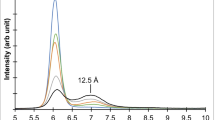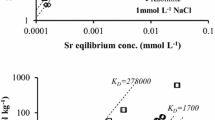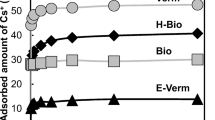Abstract
Selectivity of a number of vermiculites, montmorillonites and micas for K and Cs ions was determined by sorption of these ions from equilibrium solutions of diverse concentrations. The selectivity coefficients were related to the layer charge density and the area of the frayed edges in layer silicates.
Montmorillonites had the smallest selectivity for the two ions, while biotite and illite had the greatest selectivity. Selectivity of biotite and illite was limited to small concentrations of K, however. At greater concentrations the selectivity of vermiculite for K exceeded the selectivity of the micas.
The greater selectivity of vermiculites than montmorillonites for K and Cs ions was attributed to the greater layer charge density in vermiculites. The greater selectivity of micas than montmorillonites and vermiculites was attributed to the frayed edges of micas in addition to their larger layer charge density. As the frayed edges in illite were increased in area by removal of the interlayer K, the selectivity of illite for K also increased; thus confirming the selectivity of frayed edges for the K ions.
Résumé
La sélectivité d’un certain nombre de vermiculites. de montmorillonites, et de micas pour les ions K et Cs a été déterminée par la sorption de ces ions à partir de solutions d’équilibres de diverses concentrations. Les coefficients de sélectivité se rapportaient à la densité de charge de la couche et à la surface des bords éraillés dans les silicates de couche. Les montmorillonites ont eu la plus petite sélectivité pour les deux ions, tandis que le biotite et l’illite ont eu la plus grande sélectivité. La sélectivité des biotites et illite a été limitée à des petites concentrations de K. A des concentrations plus grandes, la sélectivité du vermiculite pour K a dépassé la sélectivité des micas. La plus grande sélectivité des vermiculites que des montmorillonites pour les ions K et Cs a été attribuée à une densité de charge plus élevée de la couche dans les vermiculites. La plus grande sélectivité des micas que des montmorillonites et des vermiculites a été attribuée aux bords éraillés des micas, en plus de leur densité de charge plus élevée. Du fait que les bordures éraillées dans l’illite se sont accrues dans la surface, par suite de la suppression de la couche intermédiaire K, la sélectivité de l’illite pour K a également augmentée; ceci confirmant la sélectivité des bordures éraillées pour les ions de K.
Kurzreferat
Die Selektivität einer Reihe von Vermiculiten, Montmorilloniten und Glimmer für K und Cs Ionen wurde durch Adsorption dieser Ionen aus Gleichgewichtslösungen verschiedener Konzentrationen bestimmt. Die Selektivitätskoeffizienten wurden in Beziehung gebracht zur Schichtenladungsdichte und zum Gebiet des abgefaserten Kanten in Schichtsilikaten. Montmorillonite haben die geringste Selektivität für die beiden Ionen, während Biotit und Illit die grösste Selektivität haben. Allerdings war die Selektivität von Biotit und Illit auf geringe Konzentrationen von K beschränkt. Bei höheren Konzentrationen übertraf die Selektivität von Vermiculit für K die Selektivität der Glimmer. Die grössere Selektivität der Vermiculite für K und Ca gegenüber den Montmorilloniten wurde der grösseren Schichtenladungsdichte in Vermiculiten zugeschrieben. Die grössere Selektivität der Glimmer gegenüber derjenigen der Montmorillonite und Vermiculite wurden den abgefaserten Kanten der Glimmer, zusätzlich zu deren grösseren Schichtenladungsdichte zugeschrieben. Bei zunehmenden Abfaserungsftächentim Illit durch Entfernung des Zwischenschichten K, nimmt auch
Резюме
Избирательность ряда вермикулитов, монтмориллонитов и слюд в отношении поглощения ионов К и Cs была определена по сорбции этих ионов из равновесных растворов различных концентраций. Установлена связь коэфициентов селективности с плотностью заряда слоев и площадью оборванных связей.
Монтмориллониты имеют наименьшую, а биотит и иллит—наибольшую селективность для обоих ионов. Селективность биотита и иллита ограничивается, однако, малыми концентрациями ионов калия. При больших концентрациях селективность вермикулита для К превосходит селективность слюд.
Более высокая селективность вермикулитов по сравнению с монтмориллонитами для К и Cs свябана с более высокой плотностью заряда слоев. Более высокая чем у монтморриллонитов и вермикулитов селективность слюд связана с оборванными связями на краяхъастмц, действующими дополнительно к их большей плотности зарядов слоев. Когда доля оборванных связей на краяхъастмц иллита была увеличена, после удаления межслоевых катионов К, селективность иллита в отношении К также увеличилась; этим была подтверждена селективность оборванных связей в отношении ионов К.
Similar content being viewed by others
References
Bolt, G. H., Sumner, M. E., and Kamphorst, A. (1963) A study of the equilibria between three categories of potassium in an illitic soil: Soil Sci. Soc. Am. Proc. 27, 294–299.
Coleman, N. T., and Le Roux, F. H. (1965) Ion-exchange displacement of cesium from soil vermiculite: Soil Sci. 99, 243–250.
Dolcater, D. L., Lotse, E. G., Syers, J. K., and Jackson, M. L. (1968) Cation exchange selectivity of some clay-sized minerals and soil materials: Soil Sci. Soc. Am. Proc. 32, 795–798.
Jackson, M. L. (1956) Soil chemical analysis— Advanced course. Published by the author, Dept of Soil Science, University of Wisconsin, Madison.
Jacobs, D. G. (1963) The effect of collapse-inducing cations on the cesium sorption properties of hydrobiotite: Int. Clay Conf. Pergamon Press, New York, 239–248.
Jacobs, D. G., and Tamura, T. (1960) The mechanism of ion fixation using radio-isotope techniques: Trans. Intern. Congr. Soil. Sci. 7th, Madison, 2, 206–214.
Krishnamoorthy, C., and Overstreet, R. (1950) An experimental evaluation of ion-exchange relationships: Soil Sci. 69. 41–53.
Marshall, C. E., and Garcia, G. (1959) Exchange equilibria in a carboxylic resin and in Attapulgite clay; J. Phys. Chem. 63, 1663–1666.
Rich, C. I., and Black, W. R. (1964) Potassium exchange as affected by cation size, pH, and mineral structure: Soil Sci. 97, 384–390.
Sawhney, B. L. (1965) Sorption of cesium from dilute solutions: Soil Sci. Soc. Am. Proc. 29, 25–28.
Sawhney, B. L. (1966) Kinetics of cesium sorption by clay minerals: Soil Sci. Soc. Am. Proc. 30, 565–569.
Sawhney, B. L. (1969) Regularity of interstratification as affected by charge density in layer silicates: Soil Sci. Soc. Am. Proc. 33, 42–46.
Sawhney, B. L., Jackson, M. L., and Corey, R. B. (1959) Cation-exchange capacity determination of soils as influenced by the cation species: Soil Sci. 87, 243–248.
Schwertmann, U. (1962) Die selektive Kationensorption der Tonfraktion einiger Böden aus Sedimenten: Z. Pflanzenernähr. Düng. Bodenkunde 97, 9–25.
Scott, A. D., and Reed, M. G. (1962) Chemical extraction of potassium from soils and micaceous minerals with solutions containing sodium tetraphenylboron, II. Biotite: Soil Sci. Soc. Am. Proc. 26, 41–45.
Wahlberg, J. S., and Fishman, M. J. (1962) Adsorption of cesium on clay minerals: Geol. Surv. Bull. 1140-A.
Wiklander, L. (1950) Fixation of potassium by clays saturated with different cations: Soil Sci. 69, 261–268.
Author information
Authors and Affiliations
Rights and permissions
About this article
Cite this article
Sawhney, B.L. Potassium and Cesium Ion Selectivity in Relation to Clay Mineral Structure. Clays Clay Miner. 18, 47–52 (1970). https://doi.org/10.1346/CCMN.1970.0180106
Received:
Published:
Issue Date:
DOI: https://doi.org/10.1346/CCMN.1970.0180106




